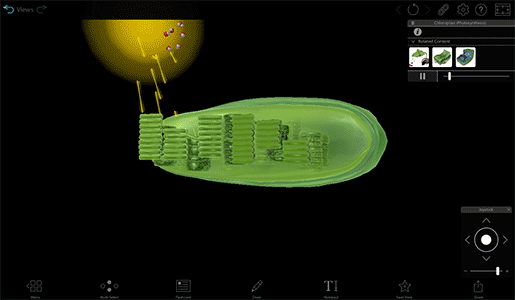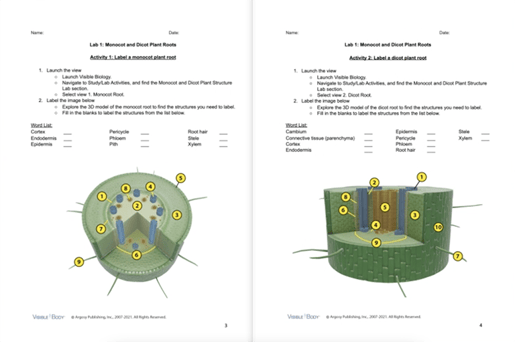Teaching High School Bio with Visible Body Suite: An Interview with Kristin Cowell of Nashoba Regional High School
Posted on 11/17/23 by Sarah Boudreau
I recently sat down with biology teacher Kristin Cowell, who shared some of the insights and roadblocks she’s encountered in the classroom. Kristin currently uses Visible Body Suite to teach AP Biology.
Kristin has taught high school science for 22 years, and this is her second year teaching at Nashoba Regional High School in Bolton, Massachusetts. In addition to AP Bio, she currently teaches chemistry and forensic science.
Without further ado, let’s dive into our discussion!
You've taught for 22 years, but you've taught biology for the past two. What's a challenge you've had while making that transition?
It's a lot of stuff to remember! I was hired in December 2021, and I was certified to teach biology that February. I do have some background in biology, but teaching it was new. I minored in bio in college, but that was twenty some-odd years ago, so it was a lot of studying for me.
At that time, we had the teacher trial, and using Visible Body was actually very helpful for me when I was studying for the certification exam! I think it helps me speak more knowledgeably to the kids about what we're doing.
What made you look for digital biology resources?
With biology, the thing that's tough is that so much of it you can't see. There's lots of simulations out there and lots of labs that will show you the macroscopic view of it—you can look at what happens during photosynthesis, you can see what's produced and so on and so forth, but you can't actually see the function within the chloroplasts, for example.
With Visible Body, it's not too cartoony—there's nothing wrong with being a little cartoony here and there, but it looks real. The kids can almost put themselves inside that tiny, tiny little cell and see what's happening there. That's a valuable experience, taking something that's abstract and making it much more concrete for them. They're doing the visuals, they're writing things down, and all of that interaction makes it a better experience for them, and they can better integrate the new information into what they already know.
VB Suite has prokaryotic and eukaryotic cell models in addition to the plant and animal cell models showcased in this video!
What tools and resources did you use before VB Suite?
I worked closely with bio teachers in my former school, so I know what is standard across the board: whatever simulations, videos, interactives, you can find online. Pivot’s labs tend to be pretty good. I used things like that, things that are online-based in addition to the normal, in-class labs and so on.
Last year, Visible Body came in and did a presentation to our department. Myself and the other AP Bio teacher loved it, and our department purchased it for us to start with—we'll see where it goes from there! We could make the most use of it at the moment, and we could observe the impact over a longer period of time.
I still use a lot of the other things, but I love that I can use Visible Body as a foundational experience for them as a unit. We're moving into cellular respiration at the moment, and I have that lab, and I'm ready to go! The kids can work together, we can put stuff on the screen, and it's great to get a different experience than what they've seen before.
How do you incorporate Visible Body into your classroom?
So far, we've done a couple things with it. I use the simulations, where you can zoom in on and interact with them. When we did cell structures, we used the whole lab and everything, and it wasn’t just a paper diagram. You could put the cell on the projector and zoom into it and say, “Here are the different pieces—can you see why it's called a rough endoplasmic reticulum? What's happening here, what processes are happening in this part?”
Students connect what they're seeing in 3D with the words they've been reading and the notes they've been taking. I'm really excited going into cellular respiration and photosynthesis in the next unit, because they'll be able to see the process, see how it takes place, and translate the experience into words. That will be valuable when they're trying to remember, "Where does this take place?" 
An interactive simulation in VB Suite.
How have your students responded to VB Suite?
I break up the work they do with Visible Body over several days, but they were intimidated at first when I was like, "Here's your packet!" They quickly realized, "It's not all right now, we're going to do this over a few days." I always have them for two blocks, so I tend to talk and do practice with them for one block, then they have a task or a lab to do for the second block.
The novelty of seeing something so cool and that looks 3D is very neat, and they like that, but they also get a lot from it. This is a group that practices metacognition on a regular basis—they're able to say, "Am I understanding this well? What do I do if I'm not?" They're able to look at Visible Body and identify that it's something that's helping them understand things.
Using new tools often means adjusting your approach to teaching. What adjustments have you made while using VB?
I'm in a unique position where this was my second year teaching biology. When I came in, the kids had been without a teacher for a little while, so I was trying to catch them up, so last year was just trying to get through the material and hoping you survive it.
This year, having more time and having the time to plan for a whole year, using VB has been really nice, because one of my priorities is to make it so that I'm not talking for two blocks in a row. Talking for an hour and a half straight is a lot for anybody. It's amazing how much more time I have now that I’m breaking this class up and doing a little bit of lecture plus an activity.

Students explore structures and concepts in 3D while completing the premade labs included in VB Suite.
Only doing pen-and-paper work is not as intriguing and not as engaging, and Visible Body does a much better job of engaging the kids and getting into it. It's been a big help in terms of finding something to reinforce what I'm lecturing about without it just being another handout, another photocopy. Labs are great, and we still do a ton of labs, but this is a great offset for that—on days when they're not physically working with something, they can go in and do this cool manipulation and really dig into what the process and the structures look like. I think that's really cool!
Bio teachers are excited about this tool. We see the value in having the kids be able to interact with it, mess around with it, and use it not only when they're in the lab, but when they want to study later on, they can use it to help them review and make sure they have a good command of the information.
Wrap-up
Huge thanks to Kristin for taking the time to chat about how she's using VB Suite to teach AP Biology!
If you're an educator who wants to take VB Suite for a test drive, you can request an institutional trial, and our education team will get you set up.
You can also read more on the Visible Body Blog:
- Make Life Sciences Classrooms More Inclusive by “Shaking Up” Assessment
- 10 Creative Uses for Flashcards in Visible Body Suite
- K-12 Funding Guide: Bring Visible Body to Your Classroom
- How Can I Use Visible Biology to Teach State Standards?
Be sure to subscribe to the Visible Body Blog for more anatomy awesomeness!
Are you an instructor? We have award-winning 3D products and resources for your anatomy and physiology course! Learn more here.



